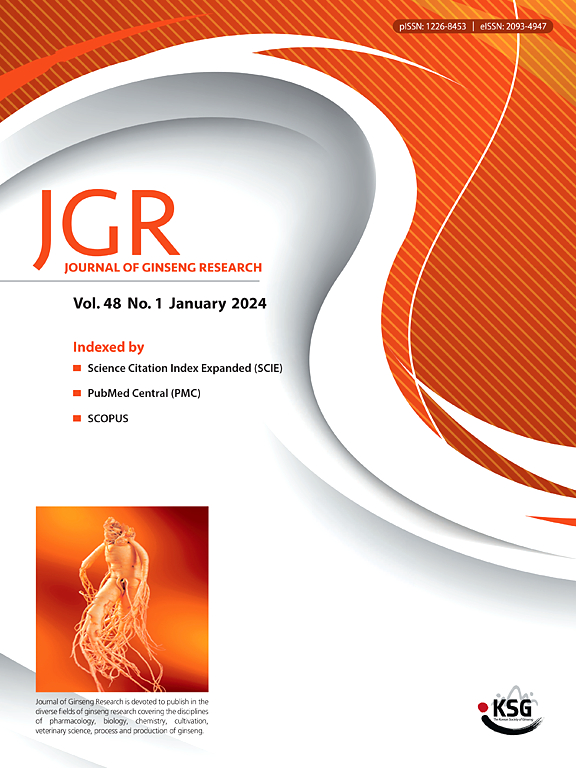Ginsenoside Rg5 modulates the TLR4 and BCL-2 pathways by inhibiting NOX1, thereby alleviating inflammation, apoptosis and pyroptosis in hyperuricemia nephropathy
IF 6.8
2区 医学
Q1 CHEMISTRY, MEDICINAL
引用次数: 0
Abstract
Background
Hyperuricemia nephropathy (HN) is a form of renal injury caused by hyperuricemia, which can progress to chronic kidney disease (CKD) and end-stage renal disease (ESRD). Ginsenoside Rg5, a major bioactive compound isolated from Panax ginseng, is recognized for its notable effects, including anti-inflammatory, antioxidant, and anticancer activities.
Method
The toxic doses of MSU crystals and Rg5-induced HK-2 cell damage were assessed using the CCK-8 assay and quantifying oxidative stress markers (MDA, GSH, SOD). Intracellular stress was evaluated with JC-1 and DCFH-DA probes. Bioinformatics analysis identified NOX1, TLR4, and Bcl-2 as potential targets. The protein expression associated with stress, inflammation, pyroptosis, and apoptosis in HK-2 cells was evaluated through a combination of Western blotting, ELISA, flow cytometry, immunofluorescence, and overexpression methods. An HN mice model was established through administration of YE and adenine, and the effects of Rg5 were evaluated. The in vivo mechanisms were further verified.
Results
Rg5 reduced serum uric acid, BUN, ADH, and creatinine levels in MSU crystals-stimulated HK-2 cells and hyperuricemic mice, alleviating renal damage. Rg5 inhibited NOX1 and suppressed the TLR4 pathway, reducing oxidative stress, inflammation, pyroptosis, and apoptosis. NOX1 overexpression reversed the effects of Rg5, while TLR4 overexpression had no effect. Rg5's efficacy was similar to NOX1 inhibitor ML171.
Conclusion
These results indicate that Rg5 can modulate the TLR4 and BCL-2 pathways by inhibiting NOX1, thereby alleviating oxidative stress, inflammation, pyroptosis, and apoptosis in HN, highlighting its potential as a therapeutic approach for controlling HN.

人参皂苷Rg5通过抑制NOX1调节TLR4和BCL-2通路,从而减轻高尿酸血症肾病的炎症、凋亡和焦亡
背景:高尿酸血症肾病(HN)是一种由高尿酸血症引起的肾损伤,可发展为慢性肾病(CKD)和终末期肾病(ESRD)。人参皂苷Rg5是一种从人参中分离出来的主要生物活性化合物,具有显著的抗炎、抗氧化和抗癌作用。方法采用CCK-8法,定量测定氧化应激标志物(MDA、GSH、SOD),观察MSU晶体的毒性剂量及rg5诱导的HK-2细胞损伤。采用JC-1和DCFH-DA探针检测细胞内应激。生物信息学分析确定NOX1、TLR4和Bcl-2为潜在靶点。通过Western blotting、ELISA、流式细胞术、免疫荧光和过表达等方法评估HK-2细胞中与应激、炎症、焦亡和凋亡相关的蛋白表达。通过给药YE和腺嘌呤建立HN小鼠模型,评价Rg5的作用。进一步验证了其体内机制。结果rg5可降低MSU晶体刺激的HK-2细胞和高尿酸血症小鼠血清尿酸、BUN、ADH和肌酐水平,减轻肾损害。Rg5抑制NOX1,抑制TLR4通路,减少氧化应激、炎症、焦亡和细胞凋亡。NOX1过表达逆转了Rg5的作用,而TLR4过表达无影响。Rg5的疗效与NOX1抑制剂ML171相似。结论Rg5可通过抑制NOX1调控TLR4和BCL-2通路,从而减轻HN的氧化应激、炎症、焦亡和凋亡,具有治疗HN的潜力。
本文章由计算机程序翻译,如有差异,请以英文原文为准。
求助全文
约1分钟内获得全文
求助全文
来源期刊

Journal of Ginseng Research
CHEMISTRY, MEDICINAL-INTEGRATIVE & COMPLEMENTARY MEDICINE
CiteScore
11.40
自引率
9.50%
发文量
111
审稿时长
6-12 weeks
期刊介绍:
Journal of Ginseng Research (JGR) is an official, open access journal of the Korean Society of Ginseng and is the only international journal publishing scholarly reports on ginseng research in the world. The journal is a bimonthly peer-reviewed publication featuring high-quality studies related to basic, pre-clinical, and clinical researches on ginseng to reflect recent progresses in ginseng research.
JGR publishes papers, either experimental or theoretical, that advance our understanding of ginseng science, including plant sciences, biology, chemistry, pharmacology, toxicology, pharmacokinetics, veterinary medicine, biochemistry, manufacture, and clinical study of ginseng since 1976. It also includes the new paradigm of integrative research, covering alternative medicinal approaches. Article types considered for publication include review articles, original research articles, and brief reports.
JGR helps researchers to understand mechanisms for traditional efficacy of ginseng and to put their clinical evidence together. It provides balanced information on basic science and clinical applications to researchers, manufacturers, practitioners, teachers, scholars, and medical doctors.
 求助内容:
求助内容: 应助结果提醒方式:
应助结果提醒方式:


